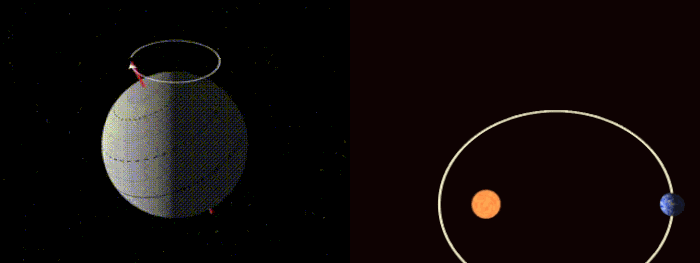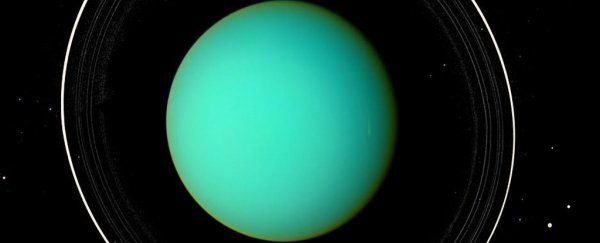Uranus is quite the individual. Most of the planets in our Solar System have their poles more or less oriented in the same direction. And most of them are spinning anticlockwise, when viewed from above. But Uranus? Its rotation axis is oriented 98 degrees relative to its orbit, and it's whirling around in a clockwise direction.
The leading hypothesis for this weirdness is that something large smacked into Uranus a long time ago, knocking it arse over teakettle. Although that scenario is not impossible, there are some pretty significant holes in this model.
Never fear, though. Astronomers at the University of Maryland have come up with a new scenario that neatly solves those issues. No, Uranus didn't get drunk on comet booze and fall over. But it could have been tilted sideways by a giant ring system.
"Wait a second," you are no doubt thinking, "Uranus doesn't have a giant ring system." And that's correct. Right now, it doesn't - its rings are faint and wispy things compared to Saturn's glorious spread.
But recent evidence from Cassini suggests rings could be temporary and short-lived - so it's possible Uranus had a much more extensive system sometime over its 4.5 billion-year past.
The problems with the smacked-upside model have mainly to do with the stuff around the planet. Neptune, for instance. If you look at the excellent video below, you'll see that Neptune and Uranus have a similar spin period.
The similarity of these spin periods implies that - as with Jupiter and Saturn - the two planets were born together. The probability of similar spin periods becomes much lower if you factor in one or more impacts large enough to tip Uranus sideways.
Uranus' moons are a problem too. A sudden tilting resulting from impact would likely disrupt and destabilise its satellite system, yet the ice planet's moons are similar in relative size and spacing to the Galilean moons.
And those moons are icy, too. Impacts large enough to tip the planet should have generated enough heat to vaporise any ice on these moons, making them mostly rocky, yet all of the planet's major moons have at least equal parts rock and ice.
According to astronomers Zeeve Rogoszinski and Douglas Hamilton of the University of Maryland, these problems are solved if Uranus had a ring system large enough to cause it to wobble on its axis like a spinning top - a phenomenon called precession - and if that precession aligned with the planet's orbital precession, where the ellipse slowly shifts position around the Sun.
You can see these two concepts animated below.
 Spin precession (left) and orbital precession (right). (Robert Simmon/NASA; WillowW/Wikimedia Commons)
Spin precession (left) and orbital precession (right). (Robert Simmon/NASA; WillowW/Wikimedia Commons)
This alignment of motion is called resonance, and it has occurred a few times in the Solar System - usually between the orbits of two or more bodies. For example, Pluto and Neptune have a 2:3 orbital resonance, which means that for every two of Pluto's orbits around the Sun, Neptune orbits three times.
The resonance between a planet's precession and its orbital precession is known as a secular spin-orbital resonance, and it can generate a large axial tilt. It's thought that a resonance of this type could have introduced an axial tilt in Saturn greater than that of Jupiter, for example.
The secular spin orbit resonance has been explored in relation to Uranus' tilt before, but with the resonance induced by the hypothetical Planet Nine. It was ultimately discarded as extremely unlikely.
But, Rogoszinski and Hamilton propose, a large disc could be a better fit. They modelled both Uranus and Neptune with large discs to see how they interact with the planets. And they found that a large disc of material accreting onto the planet - which we know is part of the formation process of giant planets - was the best fit.
But even though it produced the best result of all their models, it still couldn't get Uranus all the way prone. Over a period of a million years, it only produced a 70-degree tilt. Which means there's life in the big boom theory yet.
However, any impacting rocks required to push Uranus the rest of the way over would be much smaller - and therefore more likely.
"Although we can generate tilts greater than 70 degrees only rarely and cannot drive tilts beyond 90 degrees, a subsequent collision with an object about half the mass of Earth could tilt Uranus from 70 to 98 degrees," the researchers wrote in their paper.
"Minimising the masses and number of giant impactors from two or more to just one increases the likelihood of producing Uranus's spin states by about an order of magnitude."
These are just hypotheses for now, and it's still very much up in the air, but one thing seems certain: that must have been a wild time for Uranus, comet booze or no.
The research has been published in The Astrophysical Journal.
